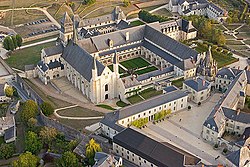
Back Abati Fontevraud Breton Abadia de Fontevrault Catalan Klášter Fontevrault Czech Fontevraudklostret Danish Abtei Fontevraud German Abatejo Fontevraud Esperanto Abadía de Fontevrault Spanish Fontevraud' klooster Estonian فنتوراود ابی Persian Fontevraudin apottiluostari Finnish
Abbaye Notre-Dame de Fontevraud | |
 | |
| Monastery information | |
|---|---|
| Full name | Abbey of Our Lady of Fontevraud |
| Other names | Abbey of Fontevrault |
| Order | Order of Fontevrault |
| Established | 1101 |
| Disestablished | 1792 |
| Dedicated to | Our Lady |
| Diocese | Angers |
| People | |
| Founder(s) | Blessed Robert of Arbrissel |
| Important associated figures | Henry II of England, Eleanor of Aquitaine, Richard the Lionheart |
| Architecture | |
| Status | suppressed |
| Functional status | Cultural Center & Museum |
| Heritage designation | Historic monument of France, World Heritage Site |
| Designated date | 1840 |
| Style | Romanesque, Gothic, Classical |
| Groundbreaking | 1101 |
| Site | |
| Coordinates | 47°10′53″N 0°03′06″E / 47.18139°N 0.05167°E |
The Royal Abbey of Our Lady of Fontevraud or Fontevrault (in French: abbaye de Fontevraud) was a monastery in the village of Fontevraud-l'Abbaye, near Chinon, in the former French Duchy of Anjou. It was founded in 1101 by the itinerant preacher Robert of Arbrissel. The foundation flourished and became the centre of a new monastic Order, the Order of Fontevraud. This order was composed of double monasteries, in which the community consisted of both men and women — in separate quarters of the abbey — all of whom were subject to the authority of the Abbess of Fontevraud. The Abbey of Fontevraud itself consisted of four separate communities, all managed by the same abbess.
The first permanent structures were built between 1110 and 1119.[1] The area where the Abbey is located was then part of what is sometimes referred to as the Angevin Empire. The king of England, Henry II, his wife, Eleanor of Aquitaine, and their son, King Richard the Lionheart, were all buried here at the end of the 12th century. It was seized and disestablished as a monastery during the French Revolution.
The Abbey is situated in the Loire Valley, a UNESCO World Heritage Site, between Chalonnes-sur-Loire and Sully-sur-Loire within the Loire-Anjou-Touraine French regional natural park (Parc naturel régional Loire-Anjou-Touraine).
The complex of monastic buildings served as a prison from 1804 to 1963. Since 1975, it has hosted a cultural centre, the Centre Culturel de l'Ouest.
- ^ Melot (1971)